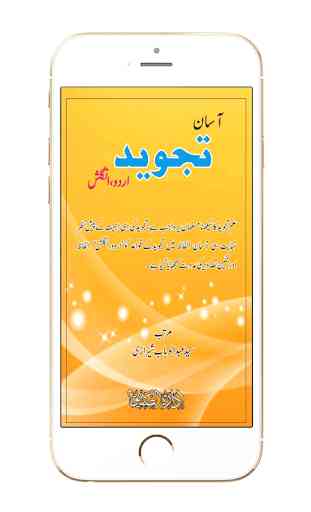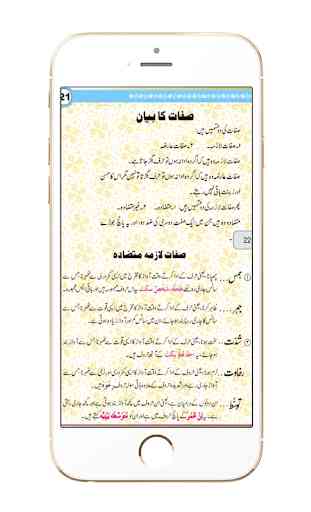Tajweed | Urdu & English
Tajweed (Arabic: تجويد tajwīd, IPA: [tædʒˈwiːd], meaning "elocution"), sometimes rendered as tajwid, refers to the rules governing pronunciation during recitation of the Quran. The term is derived from the triliteral root j-w-d meaning "to make well, make better, improve". Tajweed is a mustahab (preferred, but not an obligation) when reciting the Quran to the best of one's ability.
Main articles: Arabic alphabet, Arabic grammar, and Sun and moon letters
The Arabic alphabet has 28 basic letters, plus hamzah (ء).
ا ب ت ث ج ح خ د ذ ر ز س ش ص ض ط ظ ع غ ف ق ك ل م ن و ہ ي
The Arabic word for "the" is ال al- (i.e. the letter alif followed by lām). The lām in al- is pronounced if the letter after it is "qamarīyah" ("lunar"), but if the letter after it is "shamsīyah" ("solar"), the lām after it becomes part of the following letter (is assimilated). "Solar" and "lunar" became descriptions for these instances as the words for "the moon" and "the sun" (al-qamar and ash-shams, respectively) are examples of this rule.
Lunar letters: ا ب ج ح خ ع غ ف ق ك م هـ و ي
Solar letters: ت ث د ذ ر ز س ش ص ض ط ظ ل ن
There are 17 emission points (makhārij al-ḥurūf) of the letters, located in various regions of the throat, tongue, lips, nose, and the mouth as a whole for the prolonged (mudd) letters.
The manner of articulation (ṣifat al-ḥurūf) refers to the different attributes of the letters. Some of the characteristics have opposites, while some are individual. An example of a characteristic would be the fricative consonant sound called ṣafīr, which is an attribute of air escaping from a tube.
Thickness and thinness
See also: Emphatic consonants and Pharyngealization
The emphatic consonants خ ص ض ط ظ غ ق, known as mufakhkham letters, are pronounced with a “heavy accent” (tafkhīm). This is done by either pharyngealization /ˤ/, i.e. pronounced while squeezing one's voicebox, or by velarization /ˠ/. The remaining letters – the muraqqaq – have a “light accent” (tarqīq) as they are pronounced normally, without pharyngealization (except ع, which is often considered a pharyngeal sound).
ر (rāʼ ) is heavy when accompanied by a fatḥah or ḍammah and light when accompanied by a kasrah. If its vowel sound is cancelled, such as by a sukūn or the end of a sentence, then it is light when the first preceding voweled letter (without a sukun) has a kasrah. It is heavy if the first preceding voweled letter is accompanied by a fatḥah or ḍammah. For example, the ر at the end of the first word of the Sūrat "al-ʻAṣr" is heavy because the ع (ʻayn) has a fatḥah:
وَالْعَصْرٍ
ل (lām) is only heavy in the word Allāh. If, however, the preceding vowel is a kasrah, then the ل in Allāh is light, such as in the Bismillah:
بِسْمِ الله
Prolongation
Prolongation refers to the number of morae (beats of time) that are pronounced when a voweled letter (fatḥah, ḍammah, kasrah) is followed by a mudd letter (alif, yāʼ or wāw). The number of morae then becomes two. If these are at the end of the sentence, such as in all the verses in "al-Fatiha", then the number of morae can be more than two, but must be consistent from verse to verse. Additionally, if there is a maddah sign over the mudd letter, it is held for four or five morae when followed by a hamzah (ء) and six morae when followed by a shaddah.[1] For example, the end of the last verse in "al-Fatiha" has a six-mora maddah due to the shaddah on the ل (lām).
صِرَٰطَ ٱلَّذِينَ أَنْعَمْتَ عَلَيْهِمْ غَيْرِ ٱلمَغْضُوبِ عَلَيْهِمْ وَلاَ ٱلضَّآلِّين
Main articles: Arabic alphabet, Arabic grammar, and Sun and moon letters
The Arabic alphabet has 28 basic letters, plus hamzah (ء).
ا ب ت ث ج ح خ د ذ ر ز س ش ص ض ط ظ ع غ ف ق ك ل م ن و ہ ي
The Arabic word for "the" is ال al- (i.e. the letter alif followed by lām). The lām in al- is pronounced if the letter after it is "qamarīyah" ("lunar"), but if the letter after it is "shamsīyah" ("solar"), the lām after it becomes part of the following letter (is assimilated). "Solar" and "lunar" became descriptions for these instances as the words for "the moon" and "the sun" (al-qamar and ash-shams, respectively) are examples of this rule.
Lunar letters: ا ب ج ح خ ع غ ف ق ك م هـ و ي
Solar letters: ت ث د ذ ر ز س ش ص ض ط ظ ل ن
There are 17 emission points (makhārij al-ḥurūf) of the letters, located in various regions of the throat, tongue, lips, nose, and the mouth as a whole for the prolonged (mudd) letters.
The manner of articulation (ṣifat al-ḥurūf) refers to the different attributes of the letters. Some of the characteristics have opposites, while some are individual. An example of a characteristic would be the fricative consonant sound called ṣafīr, which is an attribute of air escaping from a tube.
Thickness and thinness
See also: Emphatic consonants and Pharyngealization
The emphatic consonants خ ص ض ط ظ غ ق, known as mufakhkham letters, are pronounced with a “heavy accent” (tafkhīm). This is done by either pharyngealization /ˤ/, i.e. pronounced while squeezing one's voicebox, or by velarization /ˠ/. The remaining letters – the muraqqaq – have a “light accent” (tarqīq) as they are pronounced normally, without pharyngealization (except ع, which is often considered a pharyngeal sound).
ر (rāʼ ) is heavy when accompanied by a fatḥah or ḍammah and light when accompanied by a kasrah. If its vowel sound is cancelled, such as by a sukūn or the end of a sentence, then it is light when the first preceding voweled letter (without a sukun) has a kasrah. It is heavy if the first preceding voweled letter is accompanied by a fatḥah or ḍammah. For example, the ر at the end of the first word of the Sūrat "al-ʻAṣr" is heavy because the ع (ʻayn) has a fatḥah:
وَالْعَصْرٍ
ل (lām) is only heavy in the word Allāh. If, however, the preceding vowel is a kasrah, then the ل in Allāh is light, such as in the Bismillah:
بِسْمِ الله
Prolongation
Prolongation refers to the number of morae (beats of time) that are pronounced when a voweled letter (fatḥah, ḍammah, kasrah) is followed by a mudd letter (alif, yāʼ or wāw). The number of morae then becomes two. If these are at the end of the sentence, such as in all the verses in "al-Fatiha", then the number of morae can be more than two, but must be consistent from verse to verse. Additionally, if there is a maddah sign over the mudd letter, it is held for four or five morae when followed by a hamzah (ء) and six morae when followed by a shaddah.[1] For example, the end of the last verse in "al-Fatiha" has a six-mora maddah due to the shaddah on the ل (lām).
صِرَٰطَ ٱلَّذِينَ أَنْعَمْتَ عَلَيْهِمْ غَيْرِ ٱلمَغْضُوبِ عَلَيْهِمْ وَلاَ ٱلضَّآلِّين
Category : Books & Reference

Related searches
Reviews (4)
Ais. H.
Jun 13, 2020
Nice detail about tajweed in Urdu and English😊
Muh. S. R.
Sep 23, 2020
This is a very good app.i learnt tomouch
Wan. T.
Jul 27, 2021
Thank you so much





One of the best app for Tajweed.